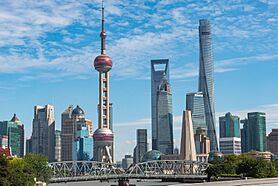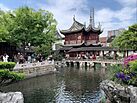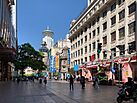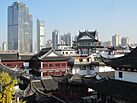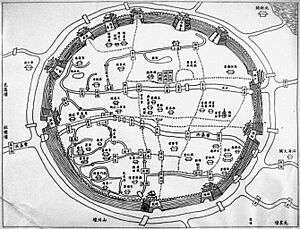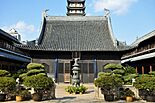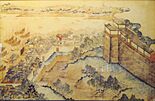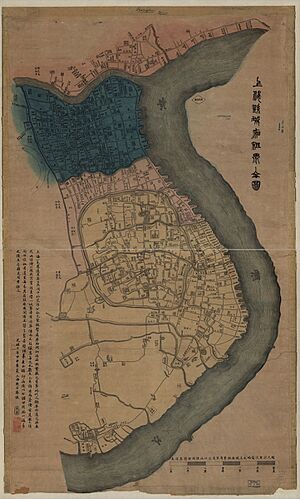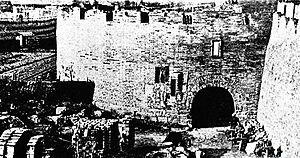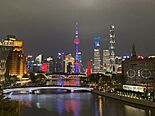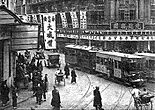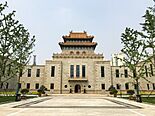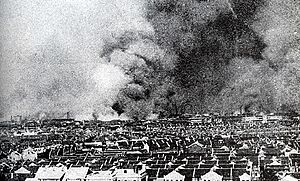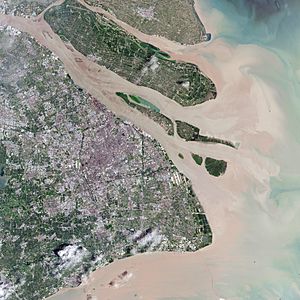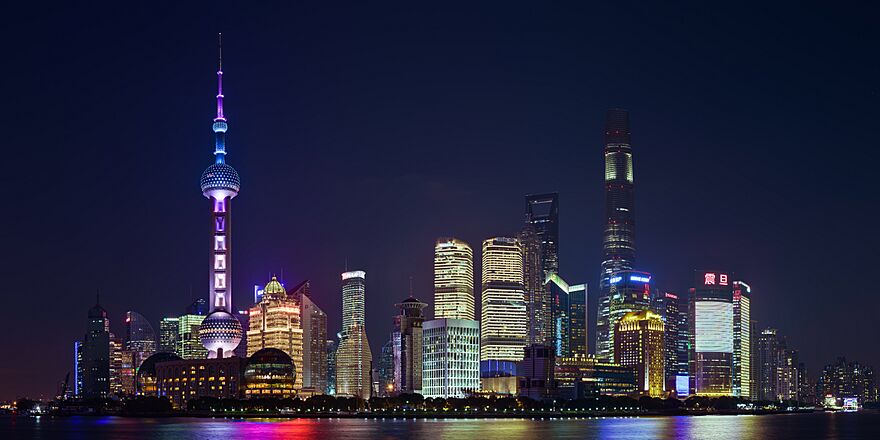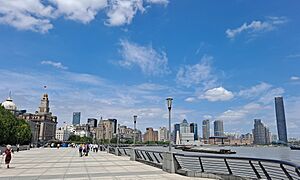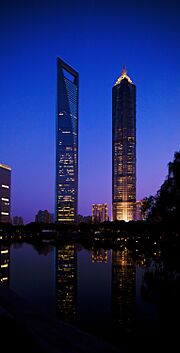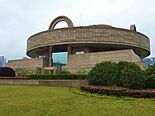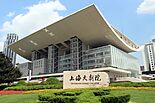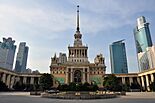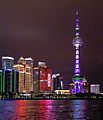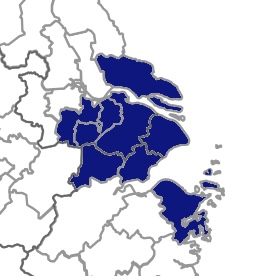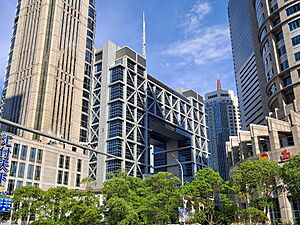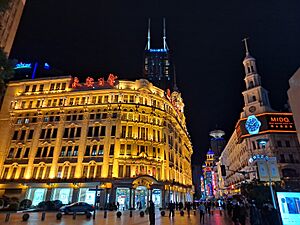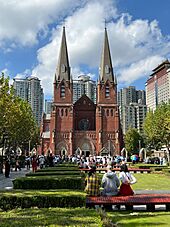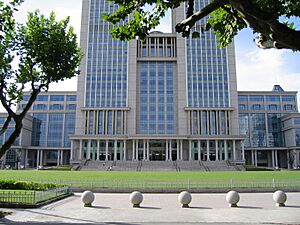Shanghai facts for kids
Quick facts for kids
Shanghai
上海
|
|
|---|---|
|
Municipality
|
|
| Municipality of Shanghai | |
|
Lujiazui from Zhapulu Bridge with the Oriental Pearl Tower (left) and Shanghai Tower (right)
Yu Garden
Nanjing Road
Shanghai Exhibition Centre
Old City of Shanghai
HSBC Building at The Bund
Jing'an Temple
|
|
| Etymology: 上海浦 (Shànghăi pǔ) The original name of the Huangpu River | |
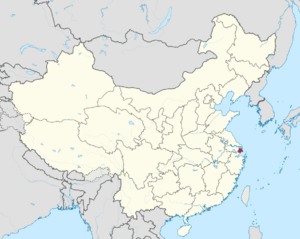
Location of Shanghai Municipality in China
|
|
| Country | China |
| Region | East China |
| Establishment of - Qinglong Town |
746 |
| - Huating County | 751 |
| - Shanghai County | 1292 |
| - Municipality | 7 July 1927 |
| Municipal seat | Huangpu District |
| Divisions - County-level - Township- level |
|
| Government | |
| • Type | Municipality |
| • Body | Shanghai Municipal People's Congress |
| Area | |
| • Municipality | 6,341 km2 (2,448 sq mi) |
| • Water | 653 km2 (252 sq mi) |
| • Metro | 14,922.7 km2 (5,761.7 sq mi) |
| Elevation | 4 m (13 ft) |
| Highest elevation | 118 m (387 ft) |
| Population
(2023)
|
|
| • Municipality | 24,874,500 |
| • Rank | 1st in China |
| • Density | 3,922.8/km2 (10,160.0/sq mi) |
| Demonym(s) | Shanghainese |
| GDP (nominal) | |
| • Municipality | CN¥ 4,722 billion (10th) US$ 670 billion |
| • Per capita | CN¥ 190,270 (2nd) US$ 27,001 |
| Time zone | UTC+08:00 (CST) |
| • Summer (DST) | UTC+09:00 (CDT) |
| Postal code |
200000–202100
|
| Area code(s) | 21 |
| ISO 3166 code | CN-SH |
| – Growth | |
| HDI (2022) | 0.895 (2nd) – very high |
| License plate prefixes |
|
| Abbreviation | SH / 沪 (Hù) |
| City flower | Yulan magnolia |
| Languages |
|
Shanghai is a huge city in China. It is one of the most populated urban areas in the world. Shanghai is located on China's eastern coast, where the Yangtze River meets the sea. The Huangpu River also flows through the city.
In 2023, about 24.87 million people lived in Shanghai. This makes it one of the largest cities globally. Shanghai is a major global center for money, business, science, technology, and culture. The Port of Shanghai is the busiest container port in the world. This means it handles more shipping containers than any other port.
Shanghai started as a small fishing village. It grew important in the 1800s because of trade and its great location as a port. After the First Opium War, Shanghai became one of the first "treaty ports" opened to European trade. This led to areas like the Shanghai International Settlement and the Shanghai French Concession being set up. By the 1930s, Shanghai was a main business and financial center in Asia.
During the Second Sino-Japanese War, a big battle happened in Shanghai. After the war, the city's global importance decreased for a while. But in the 1990s, new economic changes helped Shanghai grow rapidly again. The Pudong area, especially, saw huge development. Today, Shanghai is a top city for international trade and finance. It has the Shanghai Stock Exchange, one of Asia's largest stock markets. Shanghai is also known for its amazing buildings, like the Oriental Pearl Tower, and its unique food and culture.
Contents
What Does Shanghai Mean?
| Shanghai | |||||||||||||||||||||||||||||||||||||||||
|---|---|---|---|---|---|---|---|---|---|---|---|---|---|---|---|---|---|---|---|---|---|---|---|---|---|---|---|---|---|---|---|---|---|---|---|---|---|---|---|---|---|

"Shanghai" in regular Chinese characters
|
|||||||||||||||||||||||||||||||||||||||||
| Chinese | 上海 | ||||||||||||||||||||||||||||||||||||||||
| Hanyu Pinyin | Shànghǎi | ||||||||||||||||||||||||||||||||||||||||
| Postal | Shanghai | ||||||||||||||||||||||||||||||||||||||||
| Literal meaning | "Upon the Sea" | ||||||||||||||||||||||||||||||||||||||||
|
|||||||||||||||||||||||||||||||||||||||||
The name Shanghai comes from two Chinese characters. The first, Chinese: 上, means "upon." The second, Chinese: 海, means "sea." So, Shanghai means "On the Sea." This name was first used in the 11th century during the Song dynasty.
Some historians believe the land where Shanghai now stands was once below sea level. This would make the name "on the sea" very fitting.
Shanghai's official short name in Chinese is Chinese: 沪 (Hù). This name comes from an old word for a type of fishing tool. You can see this character on car license plates in Shanghai today.
Other Names for Shanghai
- Chinese: 申 (Shēn) or Chinese: 申城 (Shēnchéng, "Shen City") is an old name. It comes from Lord Chunshen, a nobleman from long ago whose land included Shanghai.
- Chinese: 华亭 (Huátíng) was another early name. The first county government in the area was called Huating County in 751 AD.
- Chinese: 魔都 (Módū, "Magical City") is a modern nickname. Young people often use it. It was first used in a Japanese novel in 1924, describing Shanghai as a city of both good and bad.
In English, Shanghai is sometimes called the "New York of China." This is because it's a big, busy city and a financial center. It's also known as the "Pearl of the Orient" or the "Paris of the East."
History of Shanghai
Ancient Times
People lived in the western part of Shanghai about 6,000 years ago. Long ago, during the Warring States period, Shanghai was part of the land of Lord Chunshen. He ordered the digging of the Huangpu River. This river's old name, the Chunshen River, gave Shanghai its nickname "Shēn."
Imperial China
Tang, Song, and Yuan Dynasties
During the Tang and Song dynasties, a town called Qinglong Town was a big trading port. It was founded in 746 AD. By the end of the Song dynasty, trade moved to the area we now call Shanghai. In 1074, Shanghai became a market town. In 1292, it became a county.
Ming Dynasty
Two important things happened in Shanghai during the Ming dynasty. In 1554, a city wall was built to protect the town from pirates. It was 10 meters (33 feet) high and 5 kilometers (3 miles) around. Also, a City God Temple was built in 1602. This showed how important Shanghai was becoming for trade.
Qing Dynasty
During the Qing dynasty, Shanghai became one of the most important seaports. This happened because the government changed two rules. First, in 1684, they allowed ships to travel across the ocean again. Second, in 1732, they moved the customs office to Shanghai. This gave Shanghai control over foreign trade for the whole region. By 1735, Shanghai was the main trade port for the lower Yangtze River area.
In the 1800s, more countries became interested in Shanghai because of its trade potential. During the First Opium War (1839–1842), British forces took over the city. After the war, the Treaty of Nanking opened Shanghai to international trade. Britain, France, and the United States set up their own areas outside the walled city.
In 1863, the British and American areas joined to form the Shanghai International Settlement. The French kept their own area, the Shanghai French Concession. In 1895, after the First Sino-Japanese War, Japan also became a foreign power in Shanghai. Japan built the first factories in the city, and other countries followed.
Republic Era
The Republic of China was formed in 1912. That same year, the old city walls were removed to allow the city to grow. In July 1921, the Chinese Communist Party was founded in the French Concession of Shanghai.
Shanghai's "golden age" began in 1927 when it became a special municipality. The city grew into a major business and financial center in Asia during the 1930s. Many people from different countries came to live and work in Shanghai. By 1932, Shanghai was the world's fifth-largest city, with 70,000 foreigners living there. In the 1930s, about 30,000 Jewish refugees from Europe also came to Shanghai.
Japanese Invasion
On January 28, 1932, Japanese forces attacked Shanghai. Many buildings and factories were destroyed, and many people were harmed. In 1937, the Battle of Shanghai led to the Japanese taking over the Chinese parts of the city. The foreign areas were also taken over by Japan in 1941 and remained occupied until 1945.
During World War II, thousands of Jewish refugees came to Shanghai to escape danger in Europe. They lived in a special area called the Shanghai Ghetto. The Shanghai Jewish Refugees Museum is now located there.
People's Republic Era
On May 27, 1949, the People's Liberation Army took control of Shanghai. Under the new People's Republic of China, Shanghai became one of only three cities not joined with nearby provinces. Many foreign companies moved their offices out of Shanghai after this.
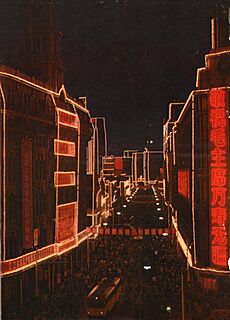
From the 1950s to the 1970s, Shanghai was a major industrial center. It also became a center for radical political ideas during the Cultural Revolution (1966–1976). Despite some challenges, Shanghai continued to grow economically.
In 1990, Deng Xiaoping allowed Shanghai to start new economic changes. This brought foreign money back to the city and led to the development of the Pudong district. Shanghai has since become a top global city. In early 2022, Shanghai had a large outbreak of COVID-19. The government put the whole city on lockdown, which caused some food shortages. The lockdown was lifted on June 1.
Geography of Shanghai
Shanghai is on China's east coast, at the mouth of the Yangtze River. The land is mostly flat, formed by river deposits and land that has been reclaimed from the sea. This means the soil is sandy, so tall buildings need very deep foundations.
Shanghai borders Zhejiang province to the south and Jiangsu province to the west and north. The city's northernmost point is on Chongming Island, which is the second-largest island in mainland China.
The city is very flat, with an average height of only 4 meters (13 feet) above sea level. Shanghai has many rivers, canals, streams, and lakes. It is known for having lots of water resources.
| Weather chart for Shanghai | |||||||||||||||||||||||||||||||||||||||||||||||
|---|---|---|---|---|---|---|---|---|---|---|---|---|---|---|---|---|---|---|---|---|---|---|---|---|---|---|---|---|---|---|---|---|---|---|---|---|---|---|---|---|---|---|---|---|---|---|---|
| J | F | M | A | M | J | J | A | S | O | N | D | ||||||||||||||||||||||||||||||||||||
|
49
8
1
|
59
9
2
|
90
13
5
|
97
19
11
|
112
24
16
|
169
27
21
|
151
32
25
|
146
32
25
|
141
28
21
|
57
23
15
|
50
17
9
|
38
11
3
|
||||||||||||||||||||||||||||||||||||
| temperatures in °C precipitation totals in mm source: The National Centers for Environmental Information (NCEI) |
|||||||||||||||||||||||||||||||||||||||||||||||
|
Imperial conversion
|
|||||||||||||||||||||||||||||||||||||||||||||||
The Huangpu River divides downtown Shanghai. The historic center of the city, called Puxi, is on the west bank. The modern financial district, Lujiazui, is on the east bank in Pudong.
Shanghai's Climate
Shanghai has a humid subtropical climate. This means it has four clear seasons. Winters are cool and damp, and sometimes temperatures drop below freezing. Summers are hot and humid, with occasional heavy rain or thunderstorms. The city can also experience typhoons in summer and early autumn.
Spring and autumn are usually the most pleasant seasons. Spring can be rainy, but autumn is often sunny and dry.
| Climate data for Shanghai (Baoshan District), 1991–2020 normals, extremes 1951–present) | |||||||||||||
|---|---|---|---|---|---|---|---|---|---|---|---|---|---|
| Month | Jan | Feb | Mar | Apr | May | Jun | Jul | Aug | Sep | Oct | Nov | Dec | Year |
| Record high °C (°F) | 23.0 (73.4) |
27.0 (80.6) |
30.9 (87.6) |
34.3 (93.7) |
36.4 (97.5) |
37.5 (99.5) |
39.7 (103.5) |
40.0 (104.0) |
38.2 (100.8) |
36.7 (98.1) |
29.2 (84.6) |
24.4 (75.9) |
40.0 (104.0) |
| Mean daily maximum °C (°F) | 8.2 (46.8) |
10.1 (50.2) |
14.3 (57.7) |
20.1 (68.2) |
25.1 (77.2) |
27.8 (82.0) |
32.4 (90.3) |
31.9 (89.4) |
27.9 (82.2) |
22.9 (73.2) |
17.5 (63.5) |
11.0 (51.8) |
20.8 (69.4) |
| Daily mean °C (°F) | 4.9 (40.8) |
6.5 (43.7) |
10.3 (50.5) |
15.7 (60.3) |
20.9 (69.6) |
24.4 (75.9) |
28.8 (83.8) |
28.5 (83.3) |
24.7 (76.5) |
19.7 (67.5) |
13.9 (57.0) |
7.5 (45.5) |
17.2 (62.9) |
| Mean daily minimum °C (°F) | 2.2 (36.0) |
3.6 (38.5) |
6.9 (44.4) |
12.0 (53.6) |
17.5 (63.5) |
21.7 (71.1) |
25.9 (78.6) |
25.9 (78.6) |
22.2 (72.0) |
16.7 (62.1) |
10.7 (51.3) |
4.4 (39.9) |
14.1 (57.5) |
| Record low °C (°F) | −10.1 (13.8) |
−7.9 (17.8) |
−5.4 (22.3) |
−0.5 (31.1) |
6.9 (44.4) |
12.3 (54.1) |
16.3 (61.3) |
18.3 (64.9) |
10.8 (51.4) |
1.7 (35.1) |
−4.2 (24.4) |
−8.5 (16.7) |
−10.1 (13.8) |
| Average precipitation mm (inches) | 69.8 (2.75) |
64.0 (2.52) |
86.5 (3.41) |
77.1 (3.04) |
90.2 (3.55) |
196.7 (7.74) |
146.9 (5.78) |
210.1 (8.27) |
116.5 (4.59) |
71.4 (2.81) |
57.5 (2.26) |
49.3 (1.94) |
1,236 (48.66) |
| Average precipitation days (≥ 0.1 mm) | 10.0 | 9.7 | 12.2 | 10.6 | 10.8 | 13.7 | 11.9 | 12.5 | 9.9 | 7.0 | 8.6 | 8.1 | 125 |
| Average snowy days | 1.9 | 1.4 | 0.4 | 0.1 | 0.1 | 0 | 0 | 0 | 0 | 0 | 0.1 | 0.7 | 4.7 |
| Average relative humidity (%) | 73 | 73 | 72 | 70 | 71 | 79 | 76 | 77 | 75 | 71 | 72 | 71 | 73 |
| Mean monthly sunshine hours | 110.4 | 115.4 | 136.6 | 157.0 | 169.7 | 120.7 | 184.7 | 186.5 | 161.2 | 157.6 | 127.1 | 127.1 | 1,754 |
| Percent possible sunshine | 34 | 37 | 37 | 40 | 40 | 28 | 43 | 46 | 44 | 45 | 40 | 41 | 40 |
| Source: China Meteorological Administration | |||||||||||||
| Climate data for Shanghai (Minhang District), 1991–2020 normals, extremes 1951–present | |||||||||||||
|---|---|---|---|---|---|---|---|---|---|---|---|---|---|
| Month | Jan | Feb | Mar | Apr | May | Jun | Jul | Aug | Sep | Oct | Nov | Dec | Year |
| Record high °C (°F) | 22.1 (71.8) |
27.0 (80.6) |
29.6 (85.3) |
34.3 (93.7) |
36.4 (97.5) |
37.5 (99.5) |
40.9 (105.6) |
39.9 (103.8) |
38.2 (100.8) |
36.0 (96.8) |
28.7 (83.7) |
24.0 (75.2) |
40.9 (105.6) |
| Mean daily maximum °C (°F) | 8.7 (47.7) |
10.7 (51.3) |
14.8 (58.6) |
20.6 (69.1) |
25.5 (77.9) |
28.3 (82.9) |
32.8 (91.0) |
32.3 (90.1) |
28.5 (83.3) |
23.6 (74.5) |
17.9 (64.2) |
11.5 (52.7) |
21.3 (70.3) |
| Daily mean °C (°F) | 4.9 (40.8) |
6.6 (43.9) |
10.4 (50.7) |
15.8 (60.4) |
20.9 (69.6) |
24.4 (75.9) |
28.8 (83.8) |
28.5 (83.3) |
24.7 (76.5) |
19.5 (67.1) |
13.7 (56.7) |
7.3 (45.1) |
17.1 (62.8) |
| Mean daily minimum °C (°F) | 1.9 (35.4) |
3.3 (37.9) |
6.8 (44.2) |
11.9 (53.4) |
17.2 (63.0) |
21.5 (70.7) |
25.8 (78.4) |
25.7 (78.3) |
21.6 (70.9) |
15.9 (60.6) |
10.1 (50.2) |
3.9 (39.0) |
13.8 (56.8) |
| Record low °C (°F) | −10.1 (13.8) |
−7.9 (17.8) |
−5.4 (22.3) |
−0.5 (31.1) |
6.9 (44.4) |
12.3 (54.1) |
16.3 (61.3) |
18.8 (65.8) |
10.8 (51.4) |
1.7 (35.1) |
−4.2 (24.4) |
−8.5 (16.7) |
−10.1 (13.8) |
| Average precipitation mm (inches) | 70.4 (2.77) |
65.4 (2.57) |
95.4 (3.76) |
82.5 (3.25) |
93.2 (3.67) |
207.3 (8.16) |
148.0 (5.83) |
187.1 (7.37) |
118.1 (4.65) |
68.4 (2.69) |
59.4 (2.34) |
50.3 (1.98) |
1,245.5 (49.04) |
| Average precipitation days (≥ 0.1 mm) | 10.9 | 10.2 | 12.9 | 11.3 | 11.2 | 14.5 | 11.7 | 12.4 | 9.8 | 7.4 | 9.1 | 8.3 | 129.7 |
| Average snowy days | 1.8 | 1.4 | 0.4 | 0 | 0 | 0 | 0 | 0 | 0 | 0 | 0.1 | 0.7 | 4.4 |
| Average relative humidity (%) | 74 | 73 | 72 | 71 | 73 | 80 | 78 | 78 | 76 | 73 | 74 | 72 | 75 |
| Mean monthly sunshine hours | 114.8 | 117.9 | 143.8 | 168.1 | 176.8 | 131.2 | 209.4 | 202.3 | 163.7 | 162.1 | 131.1 | 129.7 | 1,850.9 |
| Percent possible sunshine | 36 | 37 | 39 | 43 | 41 | 31 | 49 | 50 | 45 | 46 | 42 | 41 | 42 |
| Source: China Meteorological Administration | |||||||||||||
Shanghai's Cityscape
The Bund is a famous waterfront area along the Huangpu River. It has many beautiful buildings from the early 1900s. These buildings show different styles, like Art Deco and neoclassical. Many old foreign areas, especially the French Concession, are also well-preserved.
Shanghai also has unique modern buildings, like the Shanghai Museum and the Oriental Pearl Tower. Even with all the new buildings, the Old City still has traditional Chinese architecture, such as the Yu Garden.
Shanghai has many Art Deco buildings because of its building boom in the 1920s and 1930s. A famous architect, László Hudec, designed many of them, including the Park Hotel.
A special type of house in Shanghai is the shikumen (石库门, "stone storage door"). These are two or three-story brick houses with a heavy wooden door and a stone arch. They are built close together in straight alleys called longtang (弄堂). Shikumen houses mix Western and traditional Chinese styles. They often have a courtyard to reduce noise and allow for sunlight and fresh air.
Shanghai has many skyscrapers, especially in Lujiazui. It is one of the top five cities in the world for tall buildings. Some famous ones include the Jin Mao Tower, the Shanghai World Financial Center, and the Shanghai Tower. The Shanghai Tower is 632 meters (2,073 feet) tall, making it the tallest building in China and the third tallest in the world. It has a unique twisted design. The futuristic Oriental Pearl Tower is also in Lujiazui.
-
The Oriental Pearl Tower at night
Shanghai's Economy
Shanghai is a "showpiece" of China's growing economy. It's a global center for money, new ideas, business, and trade. The Port of Shanghai is the busiest container port in the world.
In 2023, Shanghai's economy was worth about US$670 billion. Its six biggest industries are retail, finance, IT, real estate, machine making, and car making. These industries make up about half of the city's total economic output. Shanghai is one of the wealthiest cities in China, but also one of the most expensive to live in.
Since 2018, Shanghai has hosted the China International Import Expo (CIIE) every year. This is the world's first big expo focused on imports.
Finance in Shanghai
Shanghai is a major global financial center. It ranks first in Asia and third globally for finance. The Shanghai Stock Exchange is the largest stock exchange in China and the fourth largest in the world.
In 2013, Shanghai launched the Shanghai Free-Trade Zone. This was the first free-trade zone in mainland China. It offers special rules to encourage foreign companies to invest in the city.
Manufacturing in Shanghai
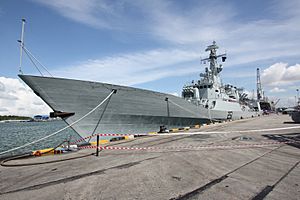
Shanghai is one of China's main industrial centers. It plays a big role in making things and in heavy industry. It is home to China's largest steelmaker, Baosteel Group, and big shipbuilding companies like Hudong–Zhonghua Shipbuilding Group. Car manufacturing is also very important. SAIC Motor, one of China's largest car companies, is based in Shanghai.
Tourism in Shanghai
Tourism is a big industry in Shanghai. In 2023, Shanghai had 3.64 million tourists, a huge increase from the previous year. The city also has many five-star hotels and tourist attractions.
Shanghai is also a popular place for conferences and meetings.
People of Shanghai
| Historical population | ||
|---|---|---|
| Year | Pop. | ±% |
| 1953 | 5,258,210 | — |
| 1964 | 6,423,017 | +22.2% |
| 1982 | 6,320,829 | −1.6% |
| 1990 | 8,348,299 | +32.1% |
| 2000 | 14,489,919 | +73.6% |
| 2010 | 20,555,098 | +41.9% |
| 2020 | 22,209,380 | +8.0% |
| Source: Census in China | ||
In 2023, Shanghai had a total population of about 24.87 million people. Most of them (89.3%) live in urban areas. Shanghai is often considered the largest city in China by urban population.
Many people in Shanghai come from other parts of China. About 40.3% of the city's residents are from other regions. Shanghai also has a number of foreign residents, including many Japanese, Americans, and Koreans.
People in Shanghai live a long time. The average life expectancy is 83.18 years, which is one of the highest in mainland China. This also means that Shanghai has an aging population, with many people aged 65 or older.
Religions in Shanghai
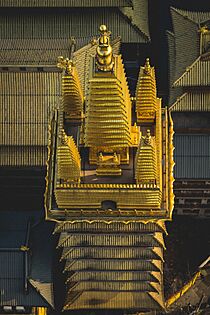
Shanghai has a mix of different religions. You can find religious buildings and groups all over the city. A survey in 2012 showed that about 13.1% of people in Shanghai belong to an organized religion. Most of these are Buddhists (10.4%), Protestants (1.9%), and Catholics (0.7%). The rest of the population may be atheists or follow traditional Chinese folk religions.
Religion in Shanghai (2012): Chinese folk religion, or atheist (87.46%) Buddhism (10.30%) Christianity (1.88%) Islam (0.36%)
Buddhism has been in Shanghai for a very long time. The Longhua Temple and the Jing'an Temple were founded centuries ago. Another important temple is the Jade Buddha Temple, known for its large jade Buddha statue.
Catholicism came to Shanghai in 1608. Important Catholic sites include the St. Ignatius Cathedral, the largest Catholic church in the city, and the She Shan Basilica. Protestant churches also exist in Shanghai.
Jewish people have also played a role in Shanghai's history. After the 1842 treaty, many Jewish families came to Shanghai for business. During World War II, thousands of Jewish refugees came to Shanghai to escape danger. They lived in the Shanghai Ghetto. The Shanghai Jewish Refugees Museum tells their story.
Islam came to Shanghai during the Yuan dynasty. The city's first mosque, Songjiang Mosque, was built in the 1300s. Many mosques were built in the 1800s and 1900s, like the Xiaotaoyuan Mosque.
Shanghai also has several folk religious temples, such as the City God Temple and the Confucian Temple of Shanghai.
Languages Spoken in Shanghai
| Ability to speak the following dialects/languages in Shanghai (2013) | ||||
|---|---|---|---|---|
| Languages | % | Can Speak | ||
| Mandarin | 97.0% | |||
| Shanghainese | 81.4% | |||
| English | 47.5% | |||
| Other Chinese | 29.7% | |||
| Other foreign languages | 7.8% | |||
| Sampled among residents ≥ 13 years old. | ||||
The local language spoken in Shanghai is Shanghainese. This language is part of the Wu Chinese language family. It is very different from Mandarin, the national language of China.
Shanghainese has been influenced by other dialects from nearby areas. After 1949, Mandarin became more widely used because the government promoted it. Since the 1990s, many people from other parts of China have moved to Shanghai. They often use Mandarin to communicate. Because of this, Shanghainese has become less common, especially among young people. However, there are now efforts to promote and protect the local language.
Education and Research
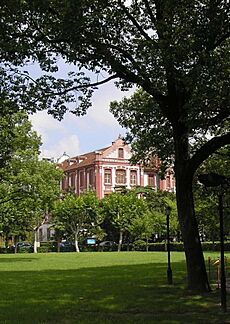
Shanghai is a global center for research and new ideas. It ranks third in the world for scientific research. It is also a major center for higher education in China. In 2023, Shanghai had 68 universities and colleges, more than any other city in East China.
Many of China's best universities are in Shanghai. These include Fudan University and Shanghai Jiao Tong University. These two universities are part of the C9 League, a group of top Chinese universities. They are often ranked among the top 100 universities globally.
Shanghai also has other highly respected universities like Tongji University and East China Normal University. The city is home to the Shanghai University of Sport, which is ranked as the best sports university in Asia.
Shanghai has many schools that work with foreign universities. For example, New York University Shanghai is the first joint university between China and the U.S.
For younger students, Shanghai offers nine years of free education. This includes five years of primary school and four years of junior secondary school. Shanghai's education system is considered one of the best in the world. In 2009 and 2012, 15-year-old students from Shanghai ranked first in math, reading, and science in a global study.
Transportation in Shanghai
Public Transport
Shanghai has a huge public transportation system. It includes metros, buses, ferries, and taxis. You can use a Shanghai Public Transport Card to pay for all of them.
The Shanghai Metro is the longest metro system in the world. As of 2021, it has 19 lines and covers 803 kilometers (499 miles). It connects all parts of the city. On March 8, 2019, it set a record with 13.3 million riders in one day.
The Shanghai maglev train opened in 2004. It is the first and fastest commercial maglev train in the world. It can reach a top speed of 430 kilometers per hour (267 mph). It takes only 7 minutes and 20 seconds to travel 30 kilometers (19 miles) between Longyang Road station and Pudong International Airport.
Shanghai also has the world's largest bus network. This includes the oldest continuously running trolleybus system. Bus fares are usually very cheap.
As of 2019, there were 40,000 taxis in Shanghai. The starting fare for taxis is 14 Chinese Yuan (about US$2.24). Ride-sharing apps like DiDi are also very popular.
Roads and Expressways

Shanghai is a major hub for China's expressway network. Many national expressways pass through or end in Shanghai. The city also has many local expressways. As of 2019, Shanghai has 12 bridges and 14 tunnels crossing the Huangpu River. The Shanghai Yangtze River Bridge is the only bridge-tunnel complex across the Yangtze River in the city.
Bicycle lanes are common in Shanghai, separating bikes from cars. In recent years, bike-sharing systems like Mobike and ofo have become very popular.
Owning a private car in Shanghai is becoming more common. However, new cars need a special license plate, which are sold in monthly auctions. This policy helps to control traffic and reduce congestion. License plates for electric cars are free.
Railways
Shanghai has four main railway stations: Shanghai railway station, Shanghai South railway station, Shanghai West railway station, and Shanghai Hongqiao railway station. All of them are connected to the metro system.
The first railway in Shanghai was built in 1876. Today, Shanghai has four high-speed railways (HSRs) that connect it to other major cities in China.
Air and Sea Travel
Shanghai is one of Asia's largest air travel hubs. The city has two main airports: Shanghai Pudong International Airport and Shanghai Hongqiao International Airport. Pudong International Airport handles most international flights, while Hongqiao International Airport mainly handles domestic flights.
The Port of Shanghai is the largest port in China. In 2010, it became the world's busiest container port, handling more shipping containers than any other port. The port is connected to the mainland by the 32-kilometer (20-mile) long Donghai Bridge.
Culture of Shanghai
Shanghai's culture is a mix of local traditions and "East Meets West" influences. The local Wuyue culture affects the Shanghainese language and Shanghai cuisine. The "Haipai" culture developed when many foreigners moved to Shanghai in the early 1900s. This culture blends Western styles with local traditions in art, fashion, music, and food.
Museums in Shanghai
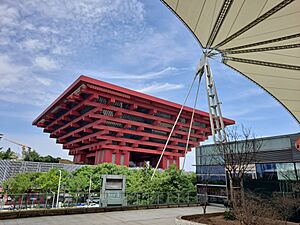
Shanghai has many important museums. The Shanghai Museum has one of the largest collections of Chinese artifacts in the world. The China Art Museum is one of the largest museums in Asia. It is located in the former China pavilion from the Expo 2010.
Other notable museums include the Shanghai Natural History Museum and the Shanghai Science and Technology Museum. There are also smaller museums at historical sites, like the Shanghai Jewish Refugees Museum.
Shanghai Cuisine

Benbang cuisine (Chinese: 本帮菜) is the traditional cooking style of Shanghai. It uses many seasonings but keeps the natural taste of the ingredients. Sugar is an important ingredient, often used with soy sauce. Famous Benbang dishes include Xiaolongbao (soup dumplings), Red braised pork belly, and Shanghai hairy crab.
Haipai cuisine is a Western-influenced cooking style. It takes ideas from French, British, Russian, and other cuisines and adapts them to local tastes. Examples include Shanghai-style borscht and crispy pork cutlets. Both Benbang and Haipai cuisines use a lot of seafood.
- Nanxiang xiaolongbao(南翔小笼包): These are famous Chinese soup dumplings from Nanxiang town. They have thin skin, tender meat, lots of soup inside, and a fresh flavor. They are served hot in bamboo baskets.
- Shanghai shengjian (上海生煎): These are Shanghai pan-fried buns. They are fried without steaming first. The filling is savory pork and green onions, and they are soupy inside. The bottoms become golden and crispy.
- Congyou banmian(葱油拌面): This is a popular noodle dish with scallion oil. The oil is made by frying chopped scallions until they are crispy. The noodles are then mixed with the oil, soy sauce, and spices.
- Paigu niangao(排骨年糕): This dish has stir-fried pork ribs and rice cakes. The pork ribs are golden and crispy outside, tender inside. The rice cakes are soft and chewy.
- Shuijing xiaren(水晶虾仁): Also called crystal shrimp, this dish uses shrimp and eggs. The shrimp is cooked until it's almost clear, giving it the "crystal" name. It's tender, crispy, and full of shrimp flavor.
Arts in Shanghai
The Shanghai School of art started in the mid-1800s. It used bright colors and often painted everyday things like flowers and birds. Western art was introduced to Shanghai in 1847. Many famous Chinese artists moved to Shanghai, making it an art center. Today, the China Art Museum is the main art facility.
Traditional Chinese opera became popular in Shanghai in the late 1800s. In the 1920s, Pingtan (a type of storytelling and singing) became very popular. Shanghai also developed its own style of Beijing Opera. A unique local opera style, Shanghai opera, was created by mixing folk songs with modern operas.
Drama (plays) started in Shanghai in the late 1800s. The city has several major theater schools and theaters, like the Shanghai Grand Theatre.
Shanghai is known as the birthplace of Chinese cinema. China's first short film (1913) and first feature film (1923) were made in Shanghai. The city's film industry grew in the 1930s, creating many famous movie stars.
Shanghai hosts several cultural festivals, including the Shanghai International Television Festival and the Shanghai International Film Festival.
Fashion in Shanghai
Since 2001, Shanghai has held its own Shanghai Fashion Week twice a year. This event showcases both international and Chinese designers. It is an important event for fashion in China.
Sports in Shanghai
Shanghai is home to several professional sports teams. These include two football (soccer) teams in the Chinese Super League: Shanghai Shenhua and Shanghai Port. The city's top basketball team, the Shanghai Sharks, is where Yao Ming started his career before joining the NBA.
The Shanghai Cricket Club started in 1858. After a break, it was re-established in 1994.
Many famous Chinese athletes come from Shanghai, such as basketball player Yao Ming and hurdler Liu Xiang.
Shanghai hosts many international sports events. Since 2004, it has hosted the Chinese Grand Prix for Formula One racing. It also hosts the Shanghai Masters tennis tournament and golf tournaments.
In 2023, Shanghai hosted 118 sports events, with 190,000 participants. In 2024, the city plans to host nearly 175 events, including Olympic qualifiers and world championships.
Environment and Parks
Parks and Resorts
Shanghai has many public parks. By 2022, the city had 670 parks, and 281 of them were free to enter. The People's Square park is in the heart of downtown Shanghai, close to other famous landmarks. Fuxing Park has French-style gardens.
Zhongshan Park is known for its statue of the composer Frédéric Chopin. It also has beautiful cherry blossom and peony gardens.
One of Shanghai's newer parks is Xujiahui Park, built in 1999. It has an artificial lake and a sky bridge. The Shanghai Botanical Garden is a large garden with many plants.
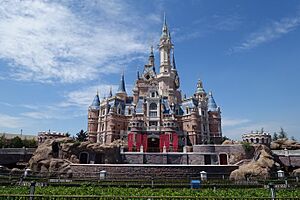
The Shanghai Disney Resort opened in 2016. It is a huge theme park with the biggest castle among all Disney resorts. Over 11 million people visited it in its first year.
Air Quality and Protection
Air pollution in Shanghai is not as bad as in some other Chinese cities, but it can still be a problem. In December 2013, air pollution levels were very high. As a result, schools stopped outdoor activities, and construction work was halted.
The city government has taken steps to improve air quality. They have moved many factories out of the city center and invested in cleaner transportation. From 2013 to 2018, air pollution from smoke, nitrogen oxide, and sulfur dioxide decreased a lot. In 2023, Shanghai's air quality improved even more.
Shanghai is also working on environmental protection. A 16-year project to clean up Suzhou Creek was finished in 2012. On July 1, 2019, Shanghai started a new system for sorting garbage into different types for recycling and disposal.
Media in Shanghai
Media in Shanghai Shanghai has many newspapers, publishers, TV stations, and internet media. Some of these media outlets are very influential across China.
Some newspapers published in Shanghai today include:
- Jiefang Daily
- Oriental Sports Daily
- Shanghai Daily
- Xinmin Evening News
The city's main broadcaster is Shanghai Media Group.
International Connections
Shanghai is home to the New Development Bank, a bank set up by the BRICS countries (Brazil, Russia, India, China, and South Africa).
Sister Cities
Shanghai has "sister city" relationships with 68 cities in 57 different countries. This helps Shanghai build friendships and connections around the world.
 Yokohama, Japan (1973)
Yokohama, Japan (1973) Osaka, Japan (1974)
Osaka, Japan (1974) Milan, Italy (1979)
Milan, Italy (1979) Rotterdam, Netherlands (1979)
Rotterdam, Netherlands (1979) San Francisco, United States (1979)
San Francisco, United States (1979) Zagreb, Croatia (1980)
Zagreb, Croatia (1980) Osaka Prefecture, Japan (1980)
Osaka Prefecture, Japan (1980) Hamhung, North Korea (1982)
Hamhung, North Korea (1982) Metro Manila, Philippines (1983)
Metro Manila, Philippines (1983) Karachi, Pakistan (1984)
Karachi, Pakistan (1984) Antwerp, Belgium (1984)
Antwerp, Belgium (1984) Montreal, Canada (1985)
Montreal, Canada (1985) Piraeus, Greece (1985)
Piraeus, Greece (1985) Pomeranian Voivodeship, Poland (1985)
Pomeranian Voivodeship, Poland (1985) Chicago, United States (1985)
Chicago, United States (1985) Hamburg, Germany (1986)
Hamburg, Germany (1986) Casablanca, Morocco (1986)
Casablanca, Morocco (1986) Marseille, France (1987)
Marseille, France (1987) São Paulo, Brazil (1988)
São Paulo, Brazil (1988) Saint Petersburg, Russia (1988)
Saint Petersburg, Russia (1988) Queensland, Australia (1989)
Queensland, Australia (1989) Istanbul, Turkey (1989)
Istanbul, Turkey (1989) Alexandria, Egypt (1992)
Alexandria, Egypt (1992) Haifa, Israel (1993)
Haifa, Israel (1993) Busan, South Korea (1993)
Busan, South Korea (1993) Ho Chi Minh City, Vietnam (1994)
Ho Chi Minh City, Vietnam (1994) Port Vila, Vanuatu (1994)
Port Vila, Vanuatu (1994) Dunedin, New Zealand (1994)
Dunedin, New Zealand (1994) Tashkent, Uzbekistan (1994)
Tashkent, Uzbekistan (1994) Porto, Portugal (1995)
Porto, Portugal (1995) Aden, Yemen (1995)
Aden, Yemen (1995) Windhoek, Namibia (1995)
Windhoek, Namibia (1995) Santiago de Cuba, Cuba (1996)
Santiago de Cuba, Cuba (1996) Rosario, Argentina (1997)
Rosario, Argentina (1997) Espoo, Finland (1998)
Espoo, Finland (1998) Jalisco, Mexico (1998)
Jalisco, Mexico (1998) Liverpool, United Kingdom (1999)
Liverpool, United Kingdom (1999) Maputo, Mozambique (1999)
Maputo, Mozambique (1999) Chiang Mai, Thailand (2000)
Chiang Mai, Thailand (2000) Dubai, United Arab Emirates (2000)
Dubai, United Arab Emirates (2000) KwaZulu-Natal, South Africa (2001)
KwaZulu-Natal, South Africa (2001) Guayaquil, Ecuador (2001)
Guayaquil, Ecuador (2001) Valparaíso, Chile (2001)
Valparaíso, Chile (2001) Barcelona, Spain (2001)
Barcelona, Spain (2001) Oslo, Norway (2001)
Oslo, Norway (2001) Constanța, Romania (2002)
Constanța, Romania (2002) Colombo, Sri Lanka (2003)
Colombo, Sri Lanka (2003) Bratislava Region, Slovakia (2003)
Bratislava Region, Slovakia (2003) Central Denmark Region, Denmark (2003)
Central Denmark Region, Denmark (2003) Cork, Ireland (2005)
Cork, Ireland (2005) East Java, Indonesia (2006)
East Java, Indonesia (2006) Basel-Stadt, Switzerland (2007)
Basel-Stadt, Switzerland (2007) Phnom Penh, Cambodia (2008)
Phnom Penh, Cambodia (2008) Auvergne-Rhône-Alpes, France (2008)
Auvergne-Rhône-Alpes, France (2008) London, United Kingdom (2009)
London, United Kingdom (2009) Salzburg, Austria (2009)
Salzburg, Austria (2009) Quebec, Canada (2011)
Quebec, Canada (2011) Budapest, Hungary (2013)
Budapest, Hungary (2013) Mumbai, India (2014)
Mumbai, India (2014) Houston, United States (2015)
Houston, United States (2015) Bangkok, Thailand (2016)
Bangkok, Thailand (2016) Sofia, Bulgaria (2016)
Sofia, Bulgaria (2016) Belgrade, Serbia (2018)
Belgrade, Serbia (2018) Lima, Peru (2018)
Lima, Peru (2018) Minsk, Belarus (2019)
Minsk, Belarus (2019) Tabriz, Iran (2019)
Tabriz, Iran (2019) Jakarta, Indonesia (2020)
Jakarta, Indonesia (2020) Melbourne, Australia
Melbourne, Australia
Foreign Consulates in Shanghai
As of September 2020, Shanghai hosts 71 consulates general and 5 consulates from different countries. These offices help their citizens and promote good relations with China.
|
See also
 In Spanish: Shanghái para niños
In Spanish: Shanghái para niños


